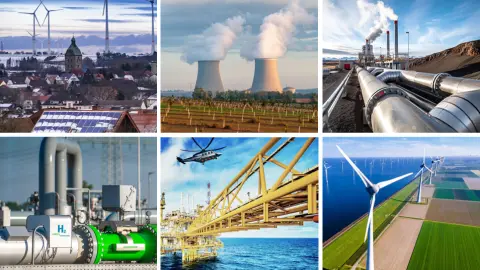Hydrogen: Beyond the hype it is all about execution
Here are our top three calls for hydrogen. The sector is shifting from announcements to execution. The US leads with blue hydrogen, while Europe is focused on green hydrogen despite cost and trade challenges. Meanwhile, hydrogen demand is moving from steel to oil refining and transportation
Call 1: Beyond the hype it’s all about execution
Last year, we anticipated that 2024 would serve as a reality check for the efforts to scale up hydrogen. But expectations have fallen even more than anticipated, with new project announcements down by over 80% globally and producers scaling back earlier commitments.
This reflects the typical hype cycle of new technologies: peak optimism for hydrogen in the run-up to 2023 followed by disillusionment in 2024.
Looking ahead to 2025, we expect more realism, though from a pessimistic perspective. The focus will shift to execution and tangible progress on projects and investments. Nevertheless, the low-carbon hydrogen market remains in its infancy. Much of the growth is likely to happen from 2028 onwards when many committed and advanced projects are likely to come online. That’s why we’re not solely focusing on 2025, but also looking ahead towards 2030.
Call 2: Progress in domestic market supply amid rising costs
Government policies and targets will be the main drivers of blue and green hydrogen project development, with the US and Europe having the highest production potential thanks to strong policy support. Just over 60% of low-carbon hydrogen globally is expected to be produced in these regions by 2030, according to Bloomberg New Energy Finance.
The US hosts the most mature project pipeline globally and about 0.4 million tons of H2 is expected to come on line in 2025. The Donaldsonville hydrogen plant in Louisiana takes the lion's share with 0.3 million tons of blue hydrogen production. In addition, a couple of electrolyser projects are likely to come online and produce 0.1 million tons of green hydrogen in 2025. The size of current electrolysers ranges from 5 to 220 megawatts, meaning that green hydrogen projects are unable to match the scale of blue hydrogen plants.
The electrolyser pipeline in the US is small compared to Europe, which limits the deployment of green hydrogen. Furthermore, Trump is likely to favour natural gas production and Carbon Capture and Storage (CCS) over extensive support for expensive electrolysers. So blue hydrogen is likely to dominate green hydrogen, allowing the industry to grow more significantly due to the larger scale of blue hydrogen projects.
Strong long-term growth of low-carbon hydrogen in the US and Europe
Hydrogen production in million metric tons per year (megatons)

Europe, on the other hand, is focusing more on green hydrogen production by kickstarting electrolyser projects. Multiple projects are expected to come online in 2025, with Shell’s 200-megawatt project in the Netherlands being the largest. A project from Air Liquide for blue hydrogen in France is expected to start production in 2025, but this project is relatively small compared to the Donaldsonville plant in the US.
Despite solid progress, the production of low-carbon hydrogen is projected to reach only four million tons by 2030, with green hydrogen contributing 2.8 million tons.
Government targets for low-carbon hydrogen are likely to be missed
This falls significantly short of the REPowerEU programme’s target of nine million tons of green hydrogen production. While the market has achieved a level of realism, this has yet to happen for policy targets.
Supply side risks
The supply side outlook faces five main risks: funding, grid congestion, rising costs, a possible trade war and performance issues.
- Funding: Most low-carbon hydrogen projects in the EU are funded by EU sources like the Projects of Common European Interest, the EU Innovation Fund, and the European Hydrogen Bank. The first auction by the European Hydrogen Bank showed that green hydrogen production costs are the lowest in Southern and Northern Europe (€5.8 to €8.8 per kg) and highest in Germany and France (€12 to €13 per kg). Despite subsidies averaging €0.46 per kg over 10 years, producers need a price premium of €3.3 to €6.5 per kg to break even, which is not yet secured by long-term contracts. In the US, besides private investors, the Department of Energy is providing loans and loan guarantees to clean energy projects including those of hydrogen. Plug Power, for example, received a $1.66bn conditional loan guarantee to produce clean hydrogen using electrolysers. However, the new administration brings uncertainty to the loan programme. The challenge of securing offtakers has also led to funding difficulties.
- Grid Congestion: Some projects struggle with securing grid connections or face future grid congestion. Reinforcing grids is complex, so enhancing the flexibility of electrolysers and green hydrogen production is crucial.
- Cost Increases: Rising material, labour and water costs are increasing project costs. Integrating electrolysers into the energy system is also more costly than anticipated, including higher grid and transportation costs. And these system costs are expected to remain high, with less optimistic long-term cost reductions. As a result, Bloomberg New Energy Finance recently raised its forecasts for green hydrogen production costs by +35%.
- Trade war and geopolitical tensions: Currently, almost all installed electrolysers in the US and EU are Western-made. Cheaper Chinese electrolysers (50-60% less expensive) are tempting developers to import them to mitigate cost increases. However, this threatens the goal of building domestic electrolyser industries in Europe and the US. The introduction of import tariffs and ongoing geopolitical tensions create uncertainty around investment decisions in 2025 - not just for electrolysers, but possibly for the entire green hydrogen supply chain, including critical materials, solar panels, and wind turbines, all of which are dominated by China. Thus, the hydrogen industry faces significant policy and trade uncertainty in 2025.
- Performance issues: In 2024, some completed hydrogen projects, particularly those involving electrolysers, faced significant performance issues.
There’s less optimism on how quickly learning rates will reduce the production cost for green hydrogen
Both established companies and startups struggled, leading to disappointing hydrogen production and impacting project outcomes. Addressing these performance challenges is crucial for the sector to achieve solid progress in 2025.
Call 3: Lower demand expectations with a shift from steel to aviation and shipping
Demand is a key bottleneck
Demand is a significant bottleneck in scaling up low-carbon hydrogen. Hydrogen project developers have only managed to secure about 10% to 15% of planned output through binding offtake contracts, primarily due to the ‘chicken and egg problem.’ Early adopters are hesitant to commit to current high price premiums for 10 to 15 years, fearing a cost disadvantage compared to competitors who adopt a wait-and-see approach to benefit from future lower prices. Without binding targets, hydrogen users such as producers of ammonia (fertilisers), chemicals (plastics), and steel still have the luxury of waiting.
Shifting demand from steel to oil refining and transportation
The steel industry exemplifies this shift. In past years, steel has been a major driver of investment announcements, particularly through clean hydrogen projects. However, we now see steel producers reconsidering earlier commitments, especially in Europe where energy prices are high, policy focus is on costly green hydrogen, and there are concerns about the availability of high-grade iron ore pellets. These pellets, ideal for hydrogen-based steelmaking, currently constitute only 7% of the iron ore supply globally.
Binding targets can be an effective way to stimulate demand
Demand from oil refiners and producers of e-fuels is expected to rise in 2025. According to Rystad Energy, most of the investments by oil majors in hydrogen are directed at replacing grey hydrogen operations with blue and green hydrogen to reduce emissions from their refineries. Another key segment is transportation, where hydrogen-derived fuels such as ammonia, methanol and synthetic jet fuel, provide low-carbon solutions for aviation and shipping. Oil refineries in Europe are expected to secure more clean hydrogen to comply with the REFuelEU Aviation initiative, requiring EU airports to use at least 1.2% green hydrogen-based fuel by 2030. The shipping sector also aims to use 5-10% of alternative fuel globally by 2030, though this target is not binding and also includes non-hydrogen fuel.
Boosting demand with CCfDs and clearer green standards
The German government launched the EU’s first Carbon Contracts for Difference (CCfD) auction in 2024. This benefits hydrogen in two ways. CCfDs subsidise both new installations and operational costs by covering the large difference between conventional and low-carbon production costs for a long period (15 years in Germany). Furthermore, lower-cost CCS solutions are excluded from the auction. A significant budget increase for 2025 auctions will support demand in Germany. Meanwhile, such initiatives could also inspire other countries to adopt similar measures, boosting hydrogen demand.
In 2025, we also expect progress on the definition of green industrial activities. Different sectors and regions have varying guidelines, making it difficult to standardise green credentials for commodities like steel, cement, plastics, and e-fuels. While hydrogen-based fuel can be blended with current fossil fuel, facilitating the integration of new technology into existing systems, this is less feasible for products like steel, cement, and plastics. For example, blending 5% hydrogen-based fuel with conventional fuel is straightforward, but it doesn’t make sense to produce 5% of a toy’s plastic parts from hydrogen-based plastic and the rest from fossil-based plastics. The solution lies in reaching a consensus on mass-balance methodologies, allowing sustainability goals to be met at the portfolio level rather than the product level.
2025: policy decisions make 2025 a pivotal year
Since low-carbon hydrogen remains more expensive than current fossil fuel-based practices, it won’t be business as usual for corporations. Therefore, policy decisions in 2025 will be crucial.
The European Commission is set to present its Clean Industrial Deal in 2025. This initiative aims to address the challenges faced by hard-to-abate sectors such as steel, cement, plastic and aluminium as detailed in the Draghi report. Policy must strike a fine balance of increased competitiveness in global markets while stimulating these sectors to quickly transition towards a net zero economy.
In the US, 2025 will reveal the full impact of policy risks, but hydrogen remains a viable market, despite developing at a slower pace than many have hoped. Under the new administration, we are confident that the hydrogen and CCS tax credits can survive and continue to play a crucial role in reducing costs, and there will likely be loosened eligibility criteria in claiming the credits. Nevertheless, any uncertainty around tax credit guideline finalisation, non-credit funding, and government-enabled hydrogen development programmes can slow down project development.
Therefore, 2025 will be a pivotal year, with significant developments and decisions shaping the future of low-carbon hydrogen.
This publication has been prepared by ING solely for information purposes irrespective of a particular user's means, financial situation or investment objectives. The information does not constitute investment recommendation, and nor is it investment, legal or tax advice or an offer or solicitation to purchase or sell any financial instrument. Read more
Download
Download article
22 January 2025
Energy Outlook 2025: Growth amid challenges This bundle contains 7 Articles
